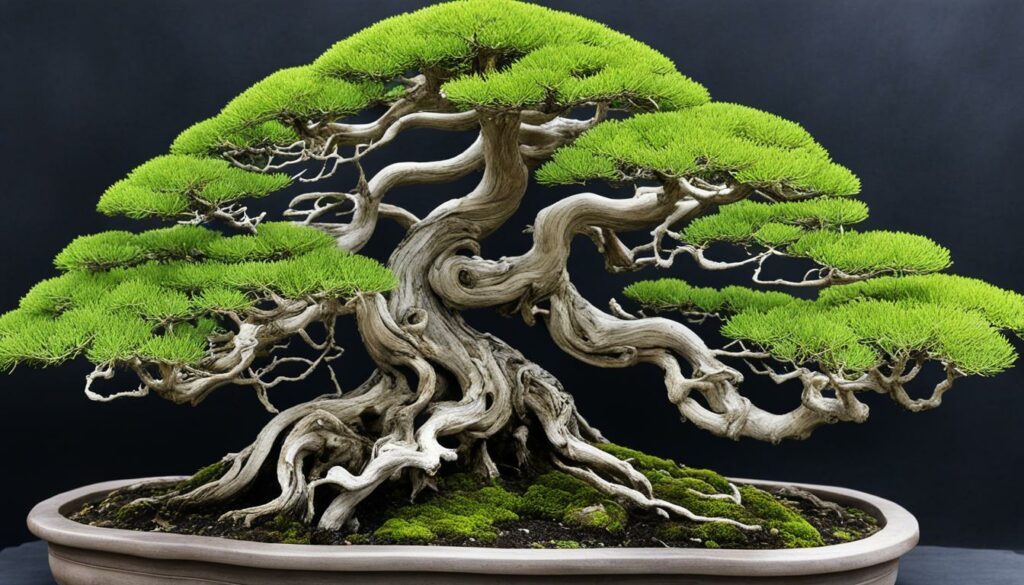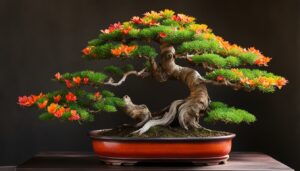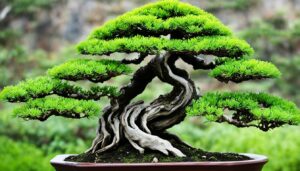Bonsai trees are a beautiful example of the art of miniaturizing trees for indoor or outdoor display. But to make each bonsai unique, it’s essential to add character that can stand the test of time. Deadwood techniques can help create that character by mimicking the effects of natural weathering and decay.
In this article, we will take a closer look at various deadwood techniques used in bonsai, including jin and shari, and how they can enhance the natural aesthetics of a tree, giving it a unique and organic look. You will explore the process of creating jin and shari, selecting the right trees, tools and materials necessary for the styling, and preserving and maintaining deadwood.
Whether you are an established bonsai enthusiast or a beginner, this guide will provide you with all the information you need to create distinctive and stunning bonsai trees that reflect nature’s true character.
Key Takeaways:
- Deadwood techniques can enhance the natural aesthetics of a bonsai tree, giving it a unique character.
- Jin and shari are the most common deadwood techniques used in bonsai.
- The selection of the right tree, tools, and materials is critical for styling deadwood.
- Preserving and maintaining deadwood requires special care to retain its appearance and longevity.
- Designing deadwood should be considered thoughtfully in the provision of a harmonious composition within the bonsai tree.
Understanding Deadwood Techniques
Deadwood techniques involve manipulating a tree’s dead wood to enhance its natural aesthetics. The techniques can mimic the effects of natural weathering and decay over time. In bonsai styling, the jin and shari techniques are commonly used to improve tree character and overall design. Jin involves stripping a portion of a dead branch to create a striking and natural-looking branch stub. Shari, on the other hand, involves removing bark from a tree’s trunk to mimic the effects of natural aging. (bonsai styling deadwood, tree aging)
By incorporating deadwood techniques in your bonsai creations, you can evoke a sense of ancient landscapes and showcase the beautiful effects of the passage of time on trees. Additionally, the techniques can add personality and visual interest to your bonsai’s overall design. Understanding the various deadwood techniques and how they work is crucial to effectively incorporate them into your bonsai styling. (bonsai styling deadwood, tree aging)
| Deadwood Technique | Description |
|---|---|
| Jin | Stripping a portion of a dead branch to create a striking and natural-looking branch stub. |
| Shari | Removing bark from a tree’s trunk to mimic the effects of natural aging. |
Tree Aging
Tree aging is a natural process that involves the decay of dead wood over time. Deadwood techniques such as jin and shari create the appearance of aged wood on a bonsai tree, mimicking the natural process of aging and weathering. By incorporating these techniques, you can add character and personality to your tree, as well as create a striking and visually appealing design. (bonsai styling deadwood, tree aging)
“Deadwood techniques are not just about the appearance, but they also bring out the natural beauty of a tree. The techniques embody the appreciation of nature’s character and timelessness, making them an integral part of the world of bonsai enthusiasts.”
Jin: Creating Striking Branch Stubs
The jin technique is one of the most popular deadwood techniques used in bonsai styling. Jin refers to the practice of stripping a portion of a branch to create a striking branch stub. This technique adds character and visual interest to a bonsai tree, giving it a unique beauty that mimics the natural aging process of a tree.
The purpose of jin is to create a deadwood feature that represents a broken or damaged branch in a tree. This technique can be used to enhance the natural aesthetics of a bonsai tree and add a sense of history and character.
To create jin, you will need a few tools, such as a jin pliers, knife, and wire brush. First, identify the branch you want to turn into a jin. Next, make a series of cuts along the branch to remove the bark. Using the wire brush, strip off the soft inner wood to expose the harder outer wood. Finally, use the jin pliers to create a rough texture on the end of the branch, creating a striking, natural-looking jin.
Jin should be used sparingly in bonsai styling, as it can be overpowering if overused. However, when used effectively, jin can add a sense of age, character, and natural beauty to a bonsai tree.
| Tool/Material | Description |
|---|---|
| Jin pliers | A specialized tool used to create texture on the end of a branch to create a jin. |
| Knife | A sharp knife used to make cuts in the bark of the branch. |
| Wire brush | A tool used to strip off the soft inner wood to expose the harder outer wood. |
Tips for Creating Natural-Looking Jin
When creating jin, aim for a natural-looking finish that mimics the appearance of a broken or damaged branch in a tree. Use the jin pliers to create a rough texture on the end of the branch, imitating the appearance of exposed wood. Additionally, consider the overall design and balance of your bonsai tree and ensure that the jin complements the tree’s overall aesthetics.
Remember to use jin sparingly and strategically to create a visually appealing and harmonious bonsai tree that showcases the beauty of deadwood techniques.
Shari: Mimicking Natural Aging
Shari is a deadwood technique in bonsai that involves stripping a portion of the bark and creating an exposed, weathered wood effect. The technique mimics the natural aging process of a tree and can add a sense of character and history to a bonsai tree.
The process of creating shari begins with selecting a suitable branch or trunk section. Once chosen, the bark is carefully removed with a bonsai carving tool, revealing the wood underneath. The wood is then shaped and textured to imitate the natural effects of weathering and decay. A mix of lime sulfur and water is then applied to the exposed wood to create a whitish, weathered appearance.
Shari can be used to create a variety of effects on a tree, from subtle accents to dramatic features. It can also be combined with other styling techniques, such as jin, to create a truly unique and visually striking bonsai tree.
When using shari in bonsai styling, it’s important to consider the overall design of the tree and ensure that the technique is used in a way that complements the tree’s natural aesthetics. Shari can also require maintenance to ensure that it remains visually appealing and doesn’t become overgrown with moss or lichen.
Overall, shari is a powerful tool in the bonsai stylist’s arsenal for creating unique and visually striking trees that evoke a sense of time and natural beauty.
Choosing the Right Tree for Deadwood Styling
Not all tree species are suitable for deadwood styling. When selecting a tree for deadwood techniques, it’s essential to consider factors such as the species’ natural growth pattern, bark texture, and trunk size. Trees with softer bark or thin trunks may not be ideal for deadwood styling, while harder, thicker bark and larger trunks provide more flexibility in design.
The types of trees that work best for achieving the desired natural aesthetics include conifers such as pine, spruce, and juniper, and deciduous trees such as maple, elm, and oak. These tree species naturally grow twisted or gnarled features that lend themselves well to deadwood styling.
When deciding on a tree for deadwood styling, consider the overall design and aesthetic you hope to achieve. Trees with unique bends or curves in their trunk and branches offer more opportunities for creative deadwood designs.
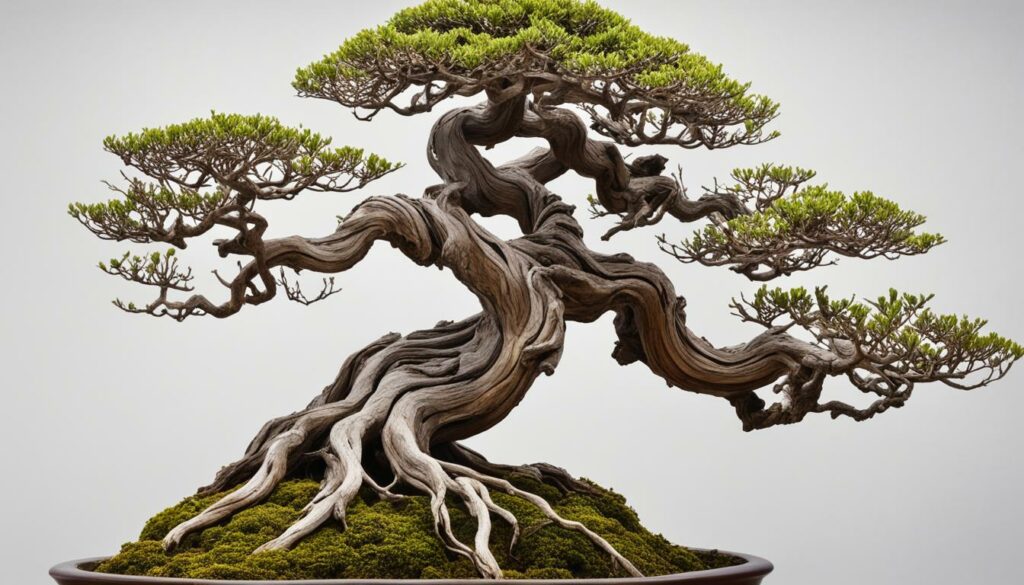
Suitable Tree Species for Deadwood Styling
| Tree Species | Natural Aesthetics | Deadwood Suitability |
|---|---|---|
| Pine | Twisted and gnarled growth patterns | Ideal for jin and shari, thicker bark allows for greater flexibility |
| Spruce | Branches grow in a zigzag pattern | Ideal for jin and shari, thick bark provides flexibility in design |
| Juniper | Slow-growing with twisted and gnarled growth patterns | Ideal for jin and shari, hardy and adaptable to styling techniques |
| Maple | Crooked, irregular trunk and branch growth patterns | Ideal for shari, thick bark allows for greater flexibility in design |
| Elm | Twisted and fluted trunk and branch growth patterns | Ideal for jin and shari, hardy and adaptable to styling techniques |
| Oak | Wavy and arching branch growth patterns | Ideal for jin and shari, thick bark allows for greater flexibility in design |
When selecting a tree for deadwood styling, always keep in mind the natural aesthetics of the species and the specific design elements you hope to create. By choosing the right tree for deadwood styling, you can elevate your bonsai tree’s overall natural aesthetic and create a truly unique and visually striking work of art.
Tools and Materials for Deadwood Techniques
Creating deadwood in bonsai requires specific tools and materials. Whether you’re creating jin or shari, having the right equipment is crucial to achieve natural-looking deadwood that enhances the natural aesthetics of your bonsai tree. Below are some of the essential tools and materials for deadwood techniques:
| Tool/Material | Description |
|---|---|
| Carving Tools | Carving tools are necessary for removing the bark and shaping the exposed wood. Some examples include gouges, knives, and chisels. |
| Wire Brushes | Wire brushes are used to create texture on the exposed wood and mimic the effects of natural aging. |
| Lime Sulfur | Lime sulfur is a solution that lightens and preserves the exposed wood. It also mimics the effects of natural decay and aging. |
| Sealants | Sealants help protect the deadwood from moisture, insects, and rot. Some examples include varnish, lacquer, and wax. |
It’s essential to use the right tools and materials for deadwood techniques, as they can significantly impact the final result. Invest in quality equipment to ensure your bonsai tree looks its best.
Techniques for Creating Jin
Creating jin in bonsai trees involves stripping a portion of the bark to create an exposed branch. It is a common method used in bonsai styling deadwood, adding visual interest and character to the tree.
Consider the following techniques when creating jin:
- Choosing the right branch: Select a branch that is thick and strong enough to withstand stripping off the bark.
- Stripping the bark: Use a jin plier or a bonsai knife to remove the bark in a controlled manner. Leave some bark near the base of the branch.
- Shaping the jin: Shape the jin to look like a natural branch stub using a carving tool or sandpaper. Create splits, knots, and other imperfections that simulate the effects of natural weathering and decay.
- Applying lime sulfur: Apply lime sulfur to the exposed wood of the jin to give it a natural grayish hue and prevent decay.
- Sealing the jin: Once the lime sulfur dries, apply a coat of sealant to protect the jin from insects and fungal growth.
When creating jin, it is important to consider the overall design of the bonsai tree. The jin should complement the tree’s natural aesthetics and enhance its character.
Examples of Jin in Bonsai Trees
Below are some examples of jin on different bonsai tree species:
| Bonsai Tree Species | Image |
|---|---|
| Juniper Bonsai | 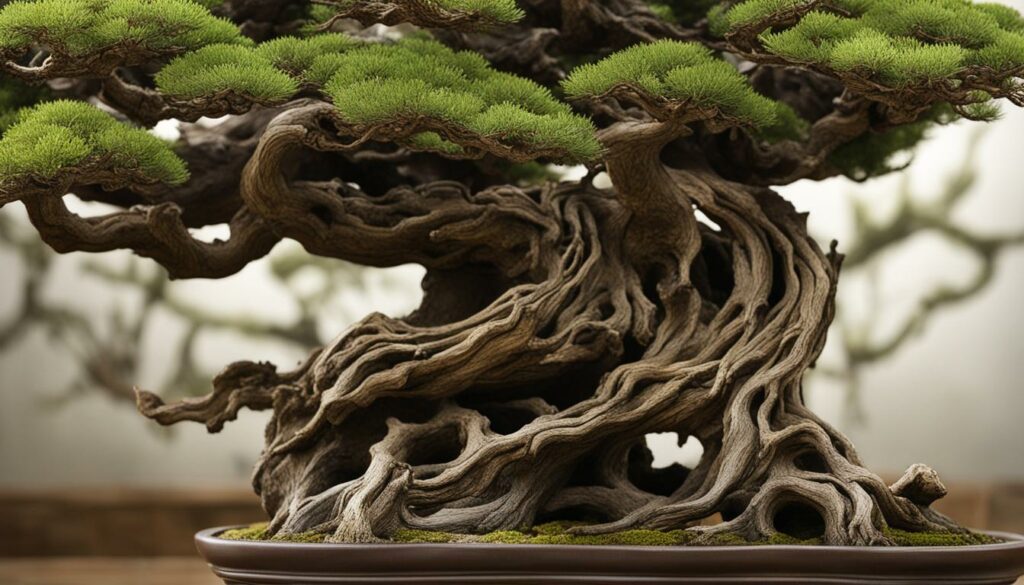 |
| Pine Bonsai |  |
| Maple Bonsai |  |
Creating natural-looking jin requires a combination of technique, tools, and patience. When done properly, jin can transform a bonsai tree into a work of art, showcasing the beauty of natural aesthetics and deadwood styling.
Techniques for Creating Shari
In bonsai styling, shari is another deadwood technique that creates a natural-looking effect of aging on a tree. By removing bark and shaping the exposed wood, you can achieve an aesthetic that complements the tree’s overall design. Here, we will discuss the techniques for creating shari that will help you bring life to your bonsai tree.
Tools Required for Creating Shari
Before starting with creating shari, it is essential to have the right tools to achieve a natural-looking appearance. The necessary tools for creating shari include:
- Carving tools – for removing the bark easily and shaping the exposed wood
- Wire brush – for removing the bark without causing too much damage to the tree
- Lime sulfur – a solution you apply to exposed wood to prevent rotting and create white colored shari
- Sealant – to prevent moisture from entering the exposed wood and also create a shiny appearance
Steps to Creating Shari
To create shari, follow these steps:
- Choose the branch or the trunk to which you want to add shari
- Remove the bark using the wire brush and carve out any excess wood that looks unnatural or does not fit with the tree’s aesthetic
- Apply lime sulfur to the exposed wood to create a white color and prevent decay. You will need to apply it multiple times to achieve the desired color.
- Allow the lime sulfur to dry and then apply sealant to protect the exposed wood from moisture and other external factors.
- Finally, after your shari has dried completely, create a contrast by adding foliage, ensuring you have a beautiful and natural looking bonsai tree.
Creating shari requires skill, but it can give your bonsai tree a unique appearance that stands the test of time. With the right tools and techniques, you can achieve an interesting and visually pleasing natural aging effect on your bonsai tree.
Preserving and Maintaining Deadwood
Deadwood styling is an essential technique in bonsai styling, but it also requires special care to maintain its appearance and longevity. If you want to keep your bonsai looking its best, you need to know how to preserve and maintain the deadwood properly.
Clean Deadwood Regularly
To keep the deadwood looking its best, you should clean it regularly. This will help prevent the buildup of dirt and debris, which can make the deadwood look dull and lifeless. You can use a soft-bristled brush or a toothbrush to gently remove any dirt or debris from the deadwood. Take care not to scrub too hard, as this could damage the wood.
Apply Lime Sulfur
Lime sulfur is a product that can be used to preserve and whiten the deadwood. It works by burning the wood slightly, which gives it a more natural look. To use lime sulfur, apply it to the deadwood using a small brush. Be careful not to get the lime sulfur on the green parts of the tree, as it can damage the living tissue.
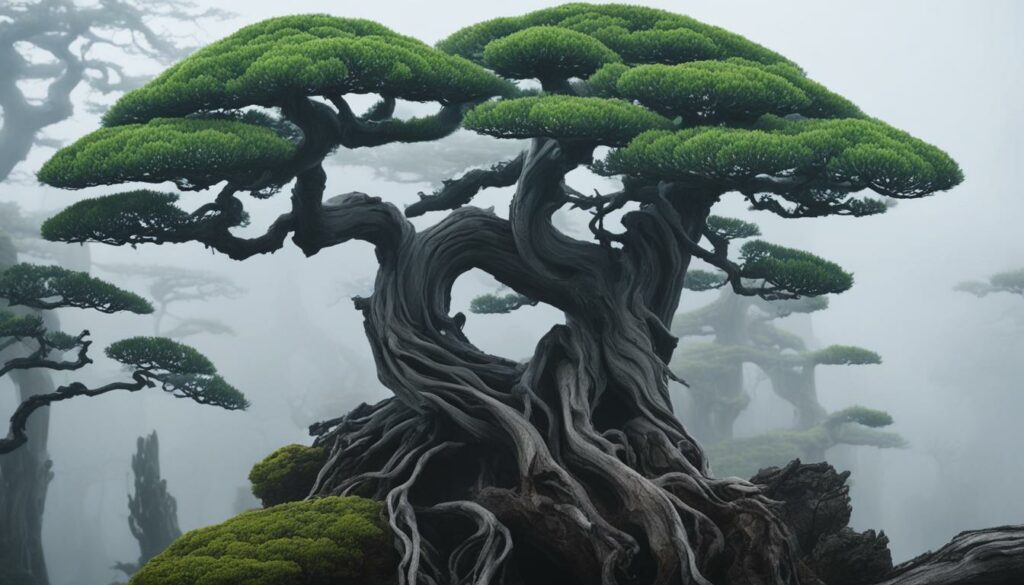
Protect the Deadwood from the Elements
Deadwood is naturally more vulnerable to the elements than living wood, and it can be easily damaged by exposure to water and sunlight. To protect the deadwood, you should keep your bonsai in a sheltered location, away from direct sunlight and rain. You can also use a sealant to protect the deadwood from moisture damage.
Monitor for Insects and Fungi
Insects and fungi can cause serious damage to deadwood if left unchecked. Regularly monitor your bonsai for signs of insect infestation or fungal growth. If you notice any issues, take action immediately to prevent the damage from spreading.
Design Considerations for Deadwood Styling
When incorporating deadwood techniques like jin and shari into your bonsai tree, it’s essential to keep in mind the overall design. Deadwood can enhance the natural aesthetics of a bonsai, but it should be incorporated thoughtfully to maintain balance and proportion.
Proportion
Proportion is key when using deadwood in your bonsai tree. Make sure the amount of deadwood is proportional to the size of the tree. Too much deadwood can overwhelm the tree’s natural aesthetics, while too little can make the deadwood seem out of place.
Balance
Balance is another consideration when using deadwood in bonsai styling. Deadwood should be balanced throughout the tree to maintain harmony. Consider the placement of the deadwood and how it balances with the living branches and leaves of the tree.
Harmony with Other Elements
Deadwood should also complement the other elements of the bonsai tree. Consider the tree’s container, accent plants, and other design elements when incorporating deadwood techniques. The deadwood should harmonize with these elements, enhancing the overall design of the tree.
When done correctly, incorporating deadwood techniques into your bonsai tree can create an organic and visually striking masterpiece. With proper design considerations, you can achieve a harmonious balance between the deadwood and living elements of your bonsai tree, enhancing its natural aesthetics and showcasing the beauty of bonsai styling.
Showcasing the Beauty of Deadwood Bonsai
Deadwood bonsai trees are a sight to behold, offering a unique sense of history and natural beauty that few other types of bonsai can match. Showcasing these unique creations requires a thoughtful approach, however, as the wrong display can detract from the overall effect.
Choosing the right container for deadwood bonsai is essential. Simple but elegant pots made from unadorned materials like stoneware or fired clay can help draw the eye to the tree itself, without distracting from its natural beauty. Brightly colored or patterned pots can be distracting and take away from the organic feel of the bonsai tree.
Background choices can also help emphasize the natural aesthetics of deadwood bonsai. Opting for a muted, earth-toned background like a burlap cloth or natural wood wall can help the tree stand out and emphasize its unique qualities. Busy or colorful backgrounds can detract from the tree itself and become the dominant focus of the display.
Lighting is also critical when showcasing deadwood bonsai. Natural light is the ideal choice, but if this is not possible, a soft, warm-toned artificial light can also help to highlight the tree’s natural textures and colors. Avoid harsh white lights that can create an unnatural or artificial feel.
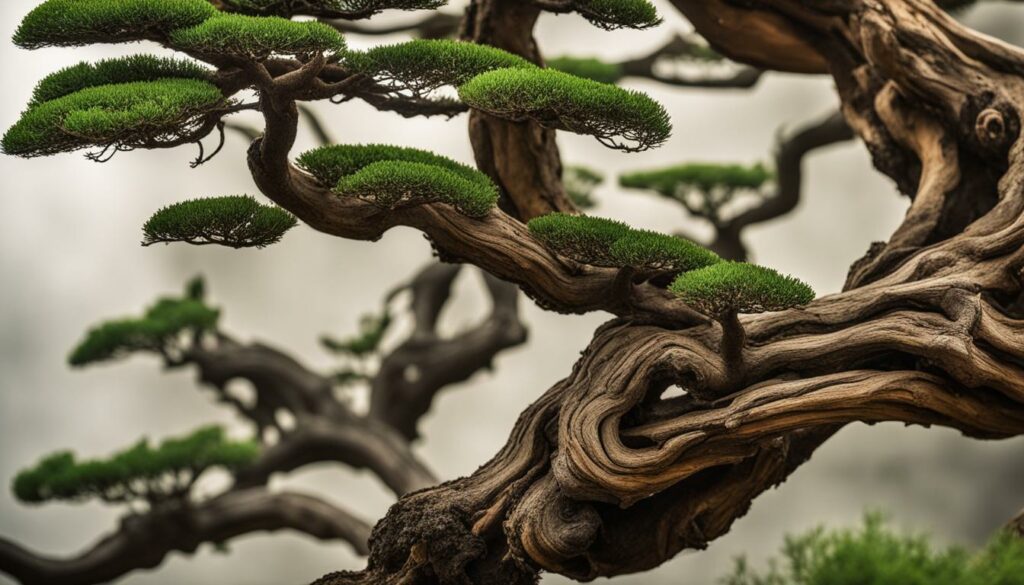
The key to showcasing the beauty of deadwood bonsai is to let the tree’s natural aesthetics speak for themselves. By selecting simple and natural background and container choices and using gentle lighting, you can create a display that highlights the organic and refined beauty of deadwood bonsai in all its glory.
Appreciating the Timeless Art of Deadwood Bonsai
Deadwood bonsai is more than just creating striking aesthetics; it’s an art form that’s much deeper than that. Deadwood techniques, like jin and shari, inspire and embody time, patience, and appreciation of nature’s beauty in every aspect. Bonsai enthusiasts have come to appreciate the unique beauty of deadwood bonsai, which evokes a sense of ancient landscapes and tells a story of trees that have lived and aged over centuries.
Deadwood bonsai styling requires not just technical skill, but also creativity and a deep understanding of the natural aesthetics of trees. It teaches patience, discipline and steadiness, and how to work with and respect the natural elements while shaping a vision for the future.
Throughout history, deadwood bonsai has been revered for its ability to tell stories, and its deep connection to nature and the world around us. It’s an art form that connects us to our roots and traditions, and through it, we can celebrate nature’s beauty and the rhythm of life.
The Essence of Deadwood Bonsai
“Deadwood bonsai is not just about creating a beautiful tree; it’s about embodying the story of a tree, the history of the land it came from and the culture it represents. It’s about creating an art form that not only inspires but also connects us to our inner selves and brings peace and tranquility to our minds.”
Deadwood bonsai is an art form that requires a deep understanding of trees and their natural behavior. Deadwood techniques like jin and shari are not just cosmetic elements but are essential components that bring out the tree’s character and history.
The beauty of deadwood styling comes not just from the visual aesthetics but from the essence of what it embodies. Through deadwood techniques, we can connect with nature and find a deeper sense of purpose and meaning in life. Deadwood bonsai is a timeless art form that has an evergreen appeal, transcending borders, cultures, and time.
Creating beautiful deadwood bonsai requires meticulous attention to detail, an eye for aesthetics, and a deep appreciation for nature and its beauty. While it may seem daunting at first, the art of bonsai styling is an adventure that rewards both the patient and the daring alike.
Conclusion
Deadwood techniques are a crucial aspect of bonsai styling that can help bring out the natural aesthetics of a tree. By using jin and shari, you can create unique and visually striking bonsai trees that evoke a sense of ancient landscapes. The beauty of deadwood bonsai lies in its ability to showcase the timeless beauty that comes with age and character.
If you are interested in incorporating deadwood techniques into your bonsai creations, keep in mind that not all tree species are suitable for this type of styling. It is essential to consider the natural aesthetics and design of the tree, as well as the tools and materials needed for jin and shari.
Remember to preserve and maintain the deadwood carefully to ensure that it remains visually appealing and contributes to the overall aesthetics of the tree. When done correctly, incorporating deadwood techniques can elevate your bonsai creations to a whole new level of artistry.
So, whether you are a seasoned bonsai enthusiast or just starting with this style of gardening, consider delving into the timeless art of deadwood bonsai. The intricate beauty of these trees will surely provide you with years of joy and appreciation for nature’s remarkable creations.
FAQ
What are deadwood techniques in bonsai?
Deadwood techniques in bonsai involve using methods like jin and shari to enhance the character and natural aesthetics of a tree.
How do deadwood techniques mimic tree aging?
Deadwood techniques in bonsai, such as jin and shari, mimic the effects of natural weathering and decay over time, creating the appearance of aged wood.
What is the purpose of jin in bonsai?
Jin is a deadwood technique that involves stripping a portion of a branch to create a striking branch stub, adding character and visual interest to a bonsai tree.
How does shari mimic natural aging?
Shari is a deadwood technique in bonsai that recreates the natural aging process of a tree by creating exposed wood areas, giving the tree a weathered and aged look.
How do I choose the right tree for deadwood styling?
Consider factors such as tree species, bark characteristics, and overall tree health when selecting a tree for deadwood techniques to achieve the desired natural aesthetics.
What tools and materials are needed for deadwood techniques?
Deadwood techniques require tools like carving tools and wire brushes, as well as materials such as lime sulfur and sealants to preserve and enhance the deadwood appearance.
What are the techniques for creating jin in bonsai?
Creating jin involves techniques such as stripping the bark, shaping the exposed wood, and applying lime sulfur to achieve natural-looking branch stubs in bonsai.
How do I create shari in bonsai?
Shari is created by removing bark and shaping the exposed wood, using techniques like carving and wire brushing, to achieve a natural and aged appearance in bonsai trees.
How do I preserve and maintain deadwood in bonsai?
Preserve deadwood by applying sealants and regularly inspecting for pests or decay. Maintain deadwood by avoiding excessive sunlight or overwatering and keeping an eye on any changes in appearance.
What design considerations should I keep in mind for deadwood styling?
When using deadwood techniques, consider factors such as proportion, balance, and harmony with other elements of the tree to ensure a visually appealing and well-designed bonsai.
How can I showcase the beauty of deadwood bonsai?
Showcase deadwood bonsai by selecting suitable containers, choosing complementary backgrounds, and using proper lighting techniques to highlight the unique beauty and character of the deadwood.
What is the significance of deadwood bonsai in the art of bonsai?
Deadwood bonsai represents an art form that embodies time, patience, and the appreciation of nature’s beauty. It adds a sense of ancient landscapes and contributes to the overall richness and artistry of bonsai creations.
